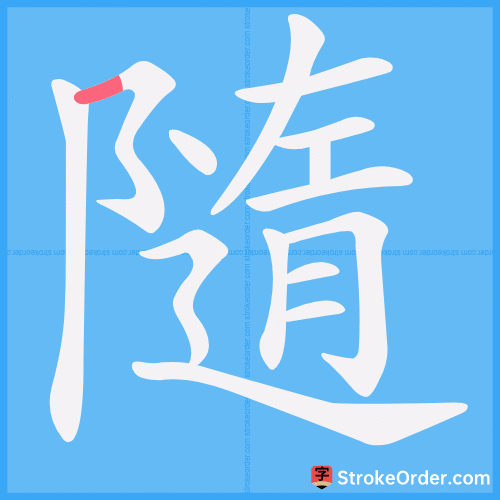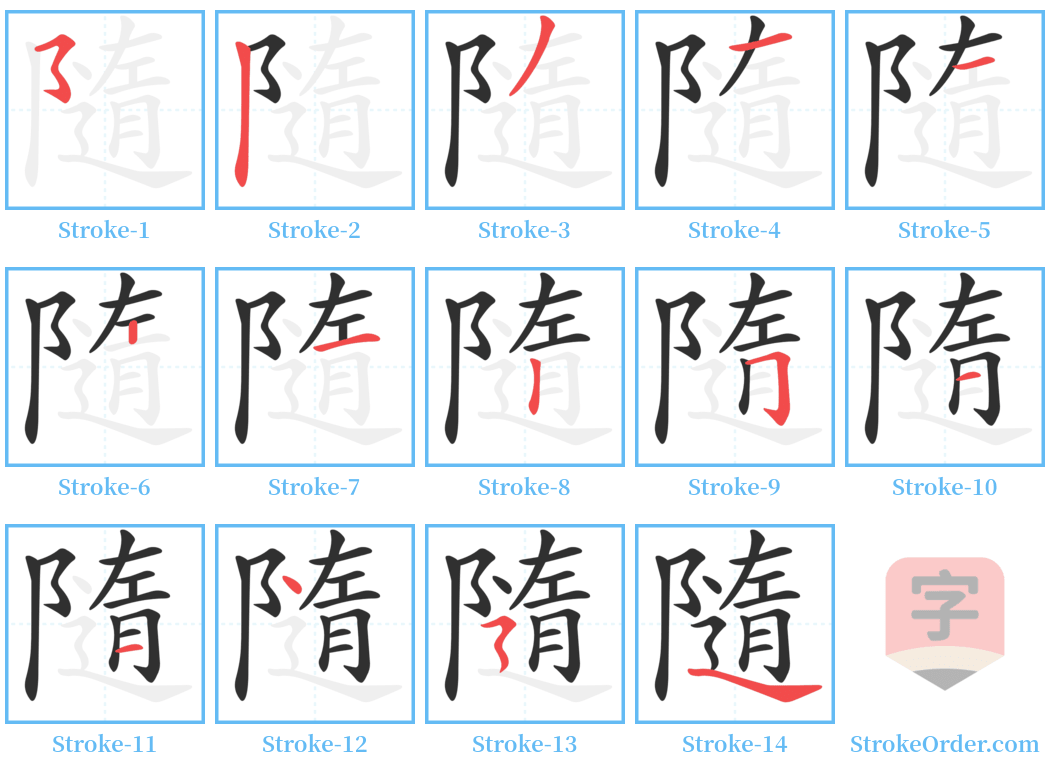隨 Stroke Order
Animated Stroke Order of 隨

Stroke Order Diagrams for 隨

Step-by-Step Handwriting Guide for 隨

Learn to Write Chinese Characters with Video Tutorials
Watch the video of writing the Chinese character "隨", learn the correct stroke order (笔顺) of the character "隨", and master the standard way of writing the character "隨".
Free Printable Handwriting Practice with Stroke Order: 隨
Printable Writing Practice Worksheet of "隨" in Portrait Orientation (Tian Zi Ge)

Printable Writing Practice Worksheet of "隨" in Landscape Orientation (Tian Zi Ge)

Information of 隨
Pinyin
suí
Radical
阝
Strokes
14 strokes
Usage
★★★
Definition
to follow / to comply with / to allow / (surname)
隨
suí
〈動〉
1. 跟着: to follow.
例如: 隨從 (follow); 隨員 (follower); 隨葬 (follow in burial); 隨即 (immediately); 隨行 (follow the crowd); 隨身 (follow around); 隨喜 (to delight in following); 隨波逐流 (to go with the flow); 隨行就市 (to follow the market).
2. 順從,任憑: to comply, to allow.
例如: 隨意 (to do as one pleases); 隨口 (to speak casually); 隨宜 (to conform to the situation); 隨和 (to be easygoing); 隨俗 (to follow customs); 隨筆 (to write casually); 隨遇而安 (to adapt to circumstances).
3. 順便,就着: by the way, on the way.
例如: 隨帶 (to bring along); 隨手關門 (close the door casually).
4. 像: to resemble.
例如: 他長得隨他父親 (He looks like his father).
5. 姓: a surname.
隨
suí
〈名〉
1. 六十四卦之一,震下兌上: one of the 64 Divinatory Symbols.
2. 中國周代國名: Sui state. The family name is Ji. It was a vassal of Chu during the late Spring and Autumn period, located in the present-day Suixian, Hubei province.
引述:
1. 《說文》: 隨,從也: "To follow."
2. 《易·雜卦》: 隨無故也: "To follow without reason."
3. 《書·禹貢》: 隨山刊木循也: "To follow the paths and trees of the mountains."
4. 《詩·大雅·民勞》: 無縱詭隨: "Do not follow blindly."
5. 《儀禮·聘禮》: 凡庭實隨入: "In the courtyard, it should be followed in." (Note: "Not to be walking together.")
6. 《儀禮·鄉射禮記》: 距隨長武: "To maintain a distance and follow closely."
7. 《荀子·天論》: 列星隨旋: "The stars follow their orbits."
8. 《韓非子·楊權》: 主失其神,虎隨其後: "The master lost his essence, and the tiger followed behind."
9. 《韓非子·說林上》: 子行而我隨之: "When you move, I follow."
10. 唐·杜甫《春夜喜雨》: 隨風潛入夜,潤物細無聲: "Following the wind, it silently seeps in at night, nourishing things without a sound."
11. 晉·陶淵明《桃花源記》: 太守即遣人隨其往,尋向所志,遂迷,不復得路: "The governor sent someone to follow them, searching for their intended path but getting lost, no longer able to find their way."
例子:
例如: 隨任 (following an elder in an official position); 隨直 (taking turns on duty); 隨班 (working with the group); 隨扈 (to follow as an attendant); 隨身燈 (the lamp placed at the foot of the dead); 隨坐 (to be implicated in someone's punishment); 隨宦 (to follow family members in official positions); 隨隨步口 (to closely follow each step); 隨起舉哀 (to cry in mourning together with the deceased's family).